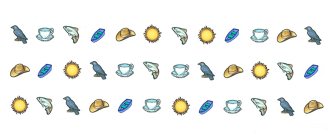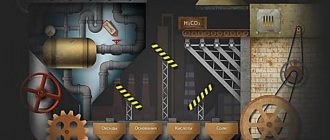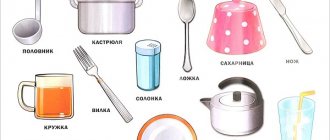When a child tries complementary feeding, it is very important not only to select high-quality products, but also to present them beautifully. A person’s eating behavior depends on how food is served. Perhaps you yourself have noticed: the prettier the appearance and table setting, the more pleasure we get from food, the better we concentrate on eating. And this, in turn, affects our health.
Therefore, when a child receives complementary foods or begins to eat on his own, it is important that he already has his own set of dishes.
Requirements for children's dishes
• Safe material is the first thing the manufacturer must guarantee. It is better to choose plates, cups and other kitchen utensils for baby food in an official store and from trusted manufacturers. It should be taken into account that some materials are unsuitable for food. For example, polyvinyl chloride, melamine and plastics containing bisphenol-A should not be used for storing food or feeding a child. Polystyrene cannot be heated.
• Labeling. The packaging or the product itself must contain indications: what this plate or cup is made of, what products it is intended for, what the conditions of its use are.
• The quality must be high, scratches, nicks, cracks and chips are unacceptable. If the paint is unevenly applied or erased on the product, it is better to choose something else for the child.
• Convenience and practicality. The design should be thought out so that it is pleasant for both you and the child to use the dishes, and easy to care for.
Materials
To make children's dishes, plastic, silicone, bamboo, porcelain, ceramics, glass, and metal are usually used.
• Plastic dishes are durable and lightweight; it's easy to wash. Heat-resistant plastic marked in the form of waves, the inscription “micro”, 5 or PP (polypropylene can withstand temperatures of 100 ° C) can be washed in the dishwasher and heated in the microwave. Plus, it's pretty easy to find a beautiful set designed in a way your little one will love.
• The silicone plate cannot be broken. Food grade silicone is safe and can be used to heat food in the microwave. It is easy to clean by hand or in the dishwasher. The silicone plate does not slip on the surface, it is convenient for the child’s first experiments in eating independently.
• Bamboo tableware is made from natural material, lightweight and durable. But you cannot heat it in a microwave oven or put it in the dishwasher, like plastic or glass. Firstly, because of the glue and resins that are used in production, and secondly, because this deteriorates the bamboo coating. But if you protect bamboo dishes from heat and wash them by hand without abrasives, they will last a long time.
• Children's porcelain is safe and durable. But at the same time he is fragile. Modern porcelain can withstand heating up to 110-160° C. Therefore, it can be used to heat dishes in the microwave (if there is no gold plated on it) and washed in the dishwasher. It is better not to give porcelain to very young children for independent use.
• Ceramic is heavier than porcelain, but also more durable. Food in a ceramic plate stays warm longer. Ceramic cookware is microwave and dishwasher safe.
• Glassware for children is wear-resistant, impact-resistant, safe, and can withstand dishwashers and microwave ovens. However, glass is sensitive to temperature changes and may burst if, for example, you pour hot soup into a cold plate. If a child accidentally breaks a plate, the pieces will not be sharp and will be easy to collect.
• Metal utensils are strong, durable and convenient to take on trips with your child. But it can get hot, so you need to make sure your baby doesn’t get burned. You can only put a metal plate or cup in the dishwasher if it is made of stainless material.
Classification by purpose and application
According to their purpose, dishes are divided into the following types:
- Kitchen - designed for cooking. These are pots, pans, steamers, kettles, baking dishes and other utensils used for cooking. This also includes cooking utensils - ladles, skimmers, masher.
- Dining room - used for setting the table and serving prepared dishes. This group includes soup bowls, plates, dishes, tea and coffee cups and services, glasses, shot glasses, everything that appears on the table during lunch. The group contains cutlery: spoons, forks, knives.
- storage - all kinds of jars, containers, oil dishes, bottles and containers. Anything that is used to store raw and cooked food. Here there are containers with different temperatures of use.
- Auxiliary - these are additional items such as spice sets, napkin holders, ice buckets.
Types of kitchen utensils
It is impossible to cook dinner without kitchen utensils, so you need to equip your kitchen with these important items. Kitchenware includes:
- Frying pans are heat-resistant kitchen utensils made of metal for frying on the stove and baking in the oven. Frying pans are classified according to the material of manufacture, diameter, depth, shape, type of handles, the presence of a non-stick coating and lid. Read more about the types of frying pans here.
- Frying pans are types of frying pans with a narrower purpose. Dutch ovens are suitable for both stovetop and oven cooking.
- Baking trays are flat metal sheets with low sides. Designed for baking in the oven.
- Pots - utensils for preparing first courses, cooking vegetables, meat, compotes, pasta. There are many types of pans on sale based on their purpose and materials, which we described in this manual.
- Ladles, teapots and milk jugs are small saucepans with one handle for quickly preparing or boiling water (milk).
- Forms for baking bakery and confectionery products. These are all kinds of molds for bread, muffins, pies.
- Forms and portion molds, baking pots. Julienne molds can also be included in this category.
Kitchen utensils also include items that are used outside the stove:
- A colander is a wide ladle with holes for draining water.
- Bowls - containers for washing, cutting, mixing products. It's hard to live without bowls in the kitchen.
- A sieve for sifting flour and straining grounds.
- Mortars are devices for manual grinding of nuts, spices, and seeds.
- Graters and manual choppers for vegetables, garlic, herbs.
- Cutting boards for raw and prepared foods.
In the process of preparing dishes, you cannot do without kitchen utensils . This:
- Skimmers, spoons, spatulas, frying forks and other important little things that help turn food over and mix ingredients.
- Pound for making puree. Progress has made its own adjustments here too, look what potato masher has appeared now.
- Ladles for first courses and compotes.
- Rolling pins for rolling out dough.
- Hammers for beating meat.
- Knives, scissors and other cutting devices.
Additionally, cookware can be classified according to purpose: for boiling, frying, stewing, baking, baking.
Types of tableware
Tableware includes all types of plates, cups, tableware and special-purpose items.
Depending on the size and purpose, plates come in different types:
- Dining rooms are deep for first courses and shallow for second courses with side dishes and independent side dishes.
- Snack bars - small and large, for serving cold and hot snacks. Diameter from 20 to 30 cm.
- Dessert bars with a diameter of 20 mm, for desserts and fruits.
- Pie - for pies, bread, croutons.
- Fish - characterized by an elongated shape.
- Caviar - miniature flat ones for caviar.
- Egg ones - with sides for scrambled eggs.
- Chill is a shell-shaped form used for oysters, stews, and salads.
- Menagerie divided into several compartments. Suitable for serving with sauces and serving several dishes at the same time.
Cups are also different:
- teahouses;
- coffee;
- broth;
- mugs – have a large volume;
- bowls.
Even more types of glasses, goblets and shot glasses. Almost every strong drink has its own glassware. The shape of the glass is not for beauty. It is determined by the aroma, taste and method of tasting. The shape helps the aroma to reveal itself and direct the drink to the right receptors in the mouth.
Cutlery for everyday life and holiday tables
There are two types of cutlery - main and auxiliary. The main ones are intended for individual use. These are spoons, forks, knives served to each guest on the plate. The main group includes tableware, snack bars, fish, dessert and fruit cutlery.
Most often, for serving in everyday life, they make do with a standard set of cutlery. Etiquette enthusiasts can purchase additional fish kits, as well as special forks for spaghetti and crab.
Auxiliary devices are used together at the table. These are various spoons and forks for putting salads and appetizers from common dishes on your plate, spatulas for cakes, tongs for pies and ice.
Cutlery is made from hard metals. For the mass consumer, this is stainless steel, and for lovers of one-piece things - cupronickel and silver . Auxiliary devices can be made of plastic, ceramics, glass, wood.
How to choose dishes for children
Choose dishes according to age. If a child is just learning to eat independently, then it is better to take unbreakable utensils and plates that cannot be scratched. To prevent the dishes from slipping, you can place a special anti-slip mat for feeding children under them.
Sometimes a child who is accustomed to drinking water, juices, or formula from a baby bottle may find it difficult to start drinking from a cup. Therefore, for the first time, you can use a sippy cup in the form of a mug with a specially shaped lid. Gradually, she will teach the child to drink water correctly from a regular cup.
Game 1. We treat guests. We play with words.
We learn to form new words from known ones (names of tableware).
Meet Tanya and Vanya. Their friends came to visit Tanya and Vanya. The guys invited the guests to the table. Look at the pictures and name what dishes the children put on the table. For oil - a butter dish, and for salt -...? (Salt shaker) For soup - a tureen, for sweets - ...? (candy bowl), for sugar - ...? (sugar bowl), for bread -... (bread box). For milk - a milk jug, for salad - ...? (salad bowl), and for coffee -...? (coffee pot). What kind of dishes does your mother put on the table when guests come to you? (carefully look at the dishes at home, name them, look at the details and name them - handle, spout, lid, bottom)
Listen to a poem about dishes. (The poem “Dispute” will help the child learn to correctly name different dishes. While reading, show the child the dishes shown in the picture)
I came up with this poem for classes with children, and they really liked it. It also helped me quickly learn the names of different utensils. I hope that you and your children will get great pleasure from the poems in pictures.
You will find this poem in pictures, as well as other tasks in pictures, in the article “Pictures of dishes for children”
You will find a presentation on this poem with pictures in good resolution for more convenient viewing with children in our VKontakte group “Child development from birth to school” (section of the “Documents” group on the right under the group video)
Dispute.
Once the dishes started arguing, Who is the most important in the world? “I’m more important,” the teapot told everyone. I warm tea for people.
“And without us they won’t be able to eat the soup. A spoon is also a friend to people.” Then the pots answered them: “You can’t cook dinner without us!”
The frying pan hissed: “That’s what I wanted to say. I fry cutlets for people, and potatoes, and omelettes.”
Stop this argument, useless conversation. We need all the dishes, each one is important to us.
We put butter in a butter dish , pour salt into a salt shaker . We put bread in the bread bin , and take soup from the tureen .
We also have a kettle with tea. We don’t miss drinking tea And pour sweet sugar from a bright sugar bowl
There is a milk jug with milk and a coffee pot with a rim. There are candies in the candy bowl for both Masha and Sveta.
There are a lot of different dishes and we need them everywhere! And we cook, and we eat, and we store food in it. (Author - Valasina A.V.)
Why do people need different dishes? What would happen if there were no dishes?
Read the poem again and ask your child to finish the words after you - the names of the utensils. For example, “We put butter in the oil...(liner), pour salt in the salt...(lonker)."
Game 2. What's missing?
We learn to accurately name the parts of the dishes. We learn to use the genitive case in speech.
Let's remember the fairy tale by K.I. Chukovsky “Fedorino's grief”.
Tell me why the dishes ran away from Fedora? Look at Fedora's broken dishes. What is missing from a cup, pan, teapot?
“A cup without...(handle).”
“A saucepan without...(lid).”
“A teapot without ... (spout).”
-Is it convenient to use a cup without a handle? Why? Why do cups have a handle? What other utensils have a handle? (At the frying pan, at the saucepan, at the kettle, at the milk jug, at the coffee pot). Why do these items need handles?
-Why do you need a lid on the pan? What other items have you seen with lids?
-Can I use a kettle without a spout? Why? What other objects have a spout? (At the watering can, at the coffee pot, at the milkman). What is the spout for?
Why did the dishes return to Fedora? What would happen if the dishes didn't come home? How did Fedora begin to take care of her dishes? (Washed it, cleaned it, doused it with boiling water, rinsed it, didn’t beat it...)
Game 3. Guess the riddle.
We learn to reason, identify and accurately name the characteristics of objects.
You will need three toys or three pictures for your child to choose a answer: a frying pan, a saucepan, a kettle (but in no case should the kettle be the first in the row).
Ask your child to guess the riddle:
“I puff, puff, puff, I don’t want to get warm anymore. The lid rang loudly: “Drink tea, the water has boiled!” What is this? Find the answer.
Do not rush to give the correct answer, give the child the opportunity to reason and think. Be sure to provoke him to prove his opinion by making a deliberate mistake. You can say: “Why did you think it was a teapot? Maybe it’s a saucepan, it’s also puffing?” Let the child listen to the riddle again and try to prove his opinion. Then ask again: “Or maybe it’s a frying pan, does it get hot too?” Re-read the riddle again and find in it the signs of the object, name them together with the child: it has a lid, it puffs and warms itself on the stove, it boils water for tea. Why isn’t this a frying pan?
These deliberate mistakes, which encourage the baby to reason, can be made by Mishka - Toropyzhka or Dunno, whom you invite to solve riddles with the baby.
Tips for parents:
- Remember that it is at the age of 3-4 that a child’s word creation begins. Don’t scold your child for making up words like “for salt – Solnitsa, for butter – Maslenitsa (Shrovetide).” The child’s word creativity must be encouraged. It indicates the child’s experimentation with words, his active mental activity. Without playing with words, it is impossible to fully master the grammar of your native language in all its completeness and richness! If you make a mistake, do not repeat it after your child, just immediately say the correct version of the word: “People agreed to call the utensils for butter a butter dish, and the utensils for salt a salt shaker.”
— Games for children 3 years old should not be long. They are always funny, entertaining, and built in dialogue with the child. Having learned the names of utensils in the game, the purpose of their parts, be sure to repeat this material (look at the dishes at home, at your grandmother’s, in the store, draw your child’s attention to the interesting shapes of handles, lids, spouts, try to sketch them; if your child is already 4- 5 years, you can look at the dishes in the museum - how they differ from our dishes at home, what they are called, what they were previously used for). When examining objects, be sure to give them to the baby’s hands so that he can run his finger along the contour, determining their shape; I tried holding it with the handle and without the handle - whichever was more convenient.
continued games with children 3 years old and older in the following article: “Dishes: tasks in pictures for children”
all the pictures of the article for more convenient viewing with children in our VKontakte group (see the group section “Documents” - presentation “Dishes”, the presentation is available for editing). Or watch the presentation below. To view full screen, you need to click the arrow icon in the lower right corner of the screen.






